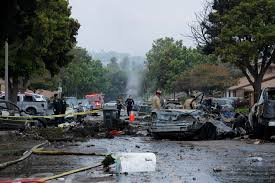A small private business jet attempting to land in foggy weather crashed into a densely populated San Diego neighborhood early Thursday morning, setting multiple homes and vehicles ablaze and causing several fatalities. The tragic incident occurred just before 4 a.m. local time in the Murphy Canyon area, near Montgomery-Gibbs Executive Airport.
Authorities have confirmed that all known fatalities are from those on board the aircraft, a Cessna Citation 550, with no deaths reported among residents in the neighborhood — a military housing community home to many enlisted Navy personnel. The Federal Aviation Administration (FAA) and National Transportation Safety Board (NTSB) are currently investigating the crash.
Jet Crashes into Residential Area
The jet, which departed from New Jersey’s Teterboro Airport on Wednesday night, made a stop in Kansas before continuing its westward journey. According to preliminary flight tracking data, the aircraft was making its final approach to Montgomery Field when it went down roughly three miles short of the runway.
First responders described a chaotic and dangerous scene. Emergency dispatch audio captured initial reports of “multiple structures and vehicles on fire,” “explosions,” and “yards completely saturated with jet fuel.” One fire engine crew reported multiple hydrant hookups as they worked to control the flames and evacuate residents.
Assistant Fire Chief for San Diego Fire-Rescue reported “fuel all over the place” and confirmed that several homes were destroyed or damaged in the resulting fires.
Investigators Focus on Low Altitude, Fog
CNN Aviation Correspondent Pete Muntean explained that weather conditions in San Diego at the time of the crash included dense fog, a low cloud ceiling, and visibility reduced to about two miles. These conditions likely made the approach to Montgomery Field significantly more difficult.
Flight tracking data revealed that the aircraft was flying at just 500 feet at its final recorded position—more than 800 feet below the recommended altitude for that segment of the instrument landing system (ILS) approach. Investigators are exploring the possibility that the pilot was “ducking under” the approach path in an effort to regain visual contact with the runway in poor visibility.
“There’s a big discrepancy between the aircraft’s altitude and what it should have been,” Muntean said. “That’s something the NTSB will look at very closely.”
Aircraft Type and Flight History
The jet involved in the crash was a Citation II, a widely used and generally reliable business jet. Experts say the model is known for its ease of operation and is often flown with a single pilot under certification.
The aircraft’s journey included a 3-hour, 42-minute flight from New Jersey to Wichita, Kansas, where it spent approximately 45 minutes on the ground before continuing to California. It was scheduled to arrive at Montgomery Field at 3:45 a.m. local time.
Because the control tower at the airport was closed at the time of the crash, the aircraft was using a common traffic advisory frequency for landing. The pilot’s last communication indicated that the jet was on a straight-in approach to Runway 28.
Devastation on the Ground
CNN’s Stephanie Elam, reporting live from the crash site, described a harrowing scene of destruction. Charred vehicles, scorched lawns, and houses with blown-out windows marked the impact zone. Residents, many of them military families, were seen evacuating with children in their arms.
“This happened in the middle of the night when people were asleep,” Elam said. “It’s remarkable that no one on the ground lost their lives.”
Jet fuel reportedly flowed down neighborhood streets and lawns, igniting additional fires and complicating firefighting efforts. Officials evacuated several hundred residents, and hazardous materials crews have been deployed to assess fuel contamination.
Investigation Underway
The NTSB has launched a full investigation, focusing on the pilot’s decisions, weather conditions, aircraft maintenance history, and flight data. Investigators will seek to recover the jet’s cockpit voice recorder and flight data recorder to determine what led to the fatal descent.
David Soucie, a former FAA safety inspector, emphasized the need to examine why the aircraft was so low on approach and whether a single pilot was operating under heavy workload in poor conditions.
Despite the tragic outcome, experts say the accident could have resulted in even greater loss of life. “The pilot may have taken steps to avoid a direct hit on homes,” Soucie noted. “In similar crashes, landing directly on structures has caused far worse damage.”
Authorities have not yet confirmed how many people were on board the aircraft at the time of the crash.

